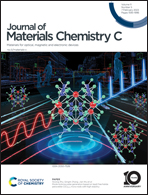Bandgap narrowing and piezochromism of doped two-dimensional hybrid perovskite nanocrystals under pressure†
Abstract
Two-dimensional (2D) halide perovskites that incorporate organic interlayers show greatly improved environmental stability and optical tunability. Here, we provide a facile pressure engineering approach to achieve control over the optical features in Mn doped 2D perovskite (PEA)2PbBr4 (PEA+ = C6H5C2H4NH3+) nanocrystals (NCs). Successive bandgap narrowing and marked piezochromism, which change the emission from orange to bluish violet, were realized. The bandgap of the Mn doped 2D perovskite (PEA)2PbBr4 NCs was steadily reduced by 480 meV under high pressure, which is much larger than that of conventional Mn-doped three-dimensional (3D) perovskite CsPbBr3 NCs (with a bandgap tuning of about 100 meV). In addition, the intrinsic band edge emission of Mn doped 2D perovskite (PEA)2PbBr4 NCs was stabilized up to 9.2 GPa. The unique steric and spring effects of asymmetric organic PEA+ bilayers accommodated the slow octahedral deformation under pressure. Furthermore, the doping of elemental Mn greatly facilitated the local lattice distortion of the 2D perovskite (PEA)2PbBr4 NCs under high pressure, which was attributed to the appearance of enhanced self-trapped exciton (STE) emission. Our studies elucidated the structure–property relationship of Mn doped layered (PEA)2PbBr4 NCs, thus providing a basis for their applications in opto-pressure sensing.

- This article is part of the themed collection: Photofunctional Materials and Transformations


 Please wait while we load your content...
Please wait while we load your content...